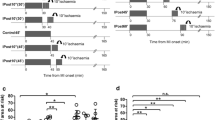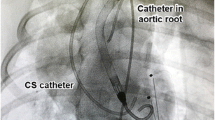Summary
There is considerable evidence implicating a key role for p38 mitogen-activated protein kinase (MAPK) in ischemic and pharmacological preconditioning against myocardial infarction. However, there have been few, if any, studies examining the role of p38 MAPK in the protection of stunned myocardium. The purpose of this study was to determine whether p38 MAPK plays a role in the adenosine A1 receptor anti-stunning effect in in vivo porcine myocardium. Regional myocardial stunning in anesthetized, open-chest pigs was induced by 15 min of left anterior descending coronary artery (LAD) occlusion and 3 h of reperfusion (RP). Animals were treated with either vehicle (n = 5), AMP579 (70 μ g/kg i.v.; 25 μ g/kg bolus + 1.5 μ g/kg/min for 30 min prior to ischemia, n = 5), the p38 MAPK inhibitor SB203580 (0.25 mg/kg i.v. bolus, n = 4) or a combination of SB203580 plus AMP579 (n = 5). Regional ventricular function was monitored by measurements of segment shortening and load insensitive parameters including preload recruitable stroke work (PRSW) and PRSW area (PRSWA). The ischemic area at risk was similar in all groups and there was no necrosis in any heart. Treatment with AMP579 significantly improved reperfusion regional PRSW and PRSWA compared to vehicle controls. The p38 inhibitor SB203580 alone did not alter the extent of myocardial stunning, but it abolished the beneficial effect of AMP579 pretreatment. These results provide the first evidence that p38 MAPK activation may play an important role in the mechanism by which adenosine agonists attenuate myocardial stunning.
Similar content being viewed by others
References
Braunward E, Kloner RA. The stunned myocardium: Prolonged, postischemic ventricular dysfunction. Circulation 1982;66:1146–1149.
Randhawa MP, Lasley RD, Mentzer RM Jr. Salutary effects of exogenous adenosine administration on in vivo myocardial stunning. J Thorac Cardiovasc Surg 1995;110:63–74.
Sekili S, Jeroudi MO, Tang XL, Zughaib M, Sun JZ, Bolli R. Effect of adenosine on myocardial ‘stunning’ in the dog. Circ Res 1995;76:82–94.
Ogawa T, Miura T, Shimamoto K, Iimura O. Activation of adenosine receptors before ischemia enhances tolerance against myocardial stunning in the rabbit heart. J Am Coll Cardiol 1996;27:225–233.
Lasley RD, Zhou Z, Hegge JO, Bunger R, Mentzer RM Jr. Adenosine attenuates in vivo myocardial stunning with minimal effects on cardiac energetics. Basic Res Cardiol 1998; 93:303–312.
Lasley RD. The protective effects of adenosine in reversibly and irreversibly injured ischemic myocardium. In: Pelleg A, Austin BL, eds. Effects of Extracellular Adenosine and ATP on Cardiomyocytes. Texas: Landes, 1998:133– 172.
Mubagwa K, Flameng W. Adenosine, adenosine receptors and myocardial protection: An updated overview. Cardiovasc Res 2001;52:25–39.
Yao Z, Gross GJ. Glibenclamide antagonizes adenosine A1 receptor-mediated cardioprotection in stunned canine myocardium. Circulation 1993;88:235–244.
Kodani E, Bolli R, Tang XL, Auchampach JA. Protection of IB-MECA against myocardial stunning in conscious rabbits is not mediated by the A1 adenosine receptor. Basic Res Cardiol 2001;96:487–496.
Kristo G, Yoshimura Y, Keith BJ, et~al. The adenosine A1/A2A receptor agonist AMP579 induces both acute and delayed preconditioning against in vivo myocardial stunning. Am J Physiol (Heart Circ Physiol) 2004;287:H2746–H753.
Clerk A, Michael A, Sugden PH. Stimulation of the p38 mitogen-activated protein kinase pathway in neonatal rat ventricular myocytes by the G protein-coupled receptor agonists, endothelin-1 and phenylephrine: A role in cardiac myocyte hypertrophy? J Cell Biol 1998;142:523–535.
Haq SE, Clerk A, Sugden PH. Activation of mitogen-activated protein kinases (p38 MAPKs, SAPKs/JNKs and ERKs) by adenosine in the perfused rat heart. FEBS Lett 1998;434:305–308.
Lazou A, Sugden PH, Clerk A. Activation of mitogen-activated protein kinases (p38-MAPKs, SAPK/JNKs and ERKs) by the G-protein-coupled receptor agonist phenylephrine in the perfused rat heart. Biochem J 1998;332(Pt 2):459–465.
Markou T, Lazou A. Phosphorylation and activation of mitogen- and stress-activated protein kinase-1 in adult rat cardiac myocytes by G-protein-coupled receptor agonists required both extracellular-signal-regulated kinase and p38 mitogen-activated protein kinase. Biochem J 2002;365:757–763.
Clerk A, Michael A, Sugden PH. Stimulation of multiple mitogen-activated protein kinase sub-families by oxidative stress and phosphorylation of the small heat shock protein, HSP25/27, in neonatal ventricular myocytes. Biochem J 1998;333:581–589.
Bogoyevitch MA, Gillespie-Brown J, Ketterman AJ, et al. Stimulation of the stress-activated mitogen-activated protein kinase subfamilies in perfused heart. p38/ERK mitogen-activated protein kinases and c-Jun N-terminal kinases are activated by ischemia/reperfusion. Circ Res 1996;79:162–173.
Yue TL, Wang C, Gu JL, et~al. Inhibition of extracellular signal-regulated kinase enhances Ischemia/Reoxygenation-induced apoptosis in cultured cardiac myocytes and exaggerates reperfusion injury in isolated perfused heart. Circ Res 2000;86:626–629.
Steenbergen C. The role of p38 mitogen-activated protein kinase in myocardial ischemia/reperfusion injury; relationship to ischemic preconditioning. Basic Res Cardiol 2002;97:276–285.
Gorog DA, Tanno M, Cao X, et~al. Inhibition of p38 MAPK activity fails to attenuate contractile dysfunction in a mouse model of low-flow ischemia. Cardiovasc Res 2004;61:123–131.
Glower DD, Spratt JA, Snow ND, et~al. Linearity of the Frank-Starling relationship in the intact heart: the concept of preload recruitable work. Circulation 1985;71:994–1009.
Glower DD, Spratt JA, Kabas JS, Davis JW, Rankin JS. Quantification of regional myocardial dysfunction after acute ischemic injury. Am J Physiol 1988;255:H85–H93.
Jahania MS, Lasley RD, Mentzer RM Jr. Ischemic preconditioning does not acutely improve load-insensitive parameters of contractility in in vivo stunned porcine myocardium. J Thorac Cardiovasc Surg 1999;117:810–817.
Lasley RD, Jahania MS, Mentzer RM Jr. Beneficial effects of adenosine A(2a) agonist CGS-21680 in infracted and stunned porcine myocardium. Am J Physiol (Heart Circ Physiol) 2001;280:H1660–H1666.
Stevens RM, Jahania MS, Mentzer RM Jr, Lasley RD. Sodium-hydrogen exchange inhibition attenuates in vivo porcine myocardium stunning. Ann Thorac Surg 2004;77:651–657.
Kristo G, Yoshimura Y, Niu J, et~al. The intermediary metabolite pyruvate attenuates stunning and reduces infarct size in in vivo porcine myocardium. Am J Physiol (Heart Circ Physiol) 2004;286:H517–H524.
Smits GJ, McVey M, Cox BF, Perrone MH, Clark KL. Cardioprotective effects of the novel adenosine A1/A2 receptor agonist AMP579 in a porcine model of myocardial infarction. J Pharmacol Exp Ther 1998;286:611–618.
Xu Z, Yang XM, Cohen MV, Neumann T, Heusch G, Downey JM. Limitation of infarct size in rabbit hearts by the novel adenosine receptor agonist AMP579 administered at reperfusion. J Mol Cell Cardiol 2000;32:2339–2347.
Xu Z, Jiao Z, Cohen MV, Downey JM. Protection from AMP579 can be added to that from either cariporide or ischemic preconditioning in ischemic rabbit heart. J Cardiovasc Pharmacol 2002;40:510–518.
Kis A, Baxter GF, Yellon DM. Limitation of myocardial reperfusion injury by AMP579, an adenosine A1/A2A receptor agonist: Role of A2A receptor and Erk1/2. Cardiovasc Drugs Ther 2003;17:415–425.
Budde JM, Velez DA, Zhao Z, et~al. Comparative study of AMP579 and adenosine in inhibition of neutrophil-mediated vascular and myocardial injury during 24 h of reperfusion. Cardiovasc Res 2000;47:294–305.
Kristo G, Yoshimura Y, Ferraris SP, Jahania MS, Mentzer RM Jr, Lasley RD. The preischemic combination of the sodium-hydrogen exchange inhibitor cariporide and the adenosine agonist AM579 acts additively to reduce myocardial infarct size. J Am Col Surg 2004;199:586–594.
Robinson AJ, Dickenson JM. Regulation of p42/p44 MAPK and p38 MAPK by the adenosine A(1) receptor in DDT(1)MF-2 cells. Eur J Pharmacol 2001;413:151–161.
Liu Q, Hofmann PA. Modulation of protein phosphatase 2a by adenosine A1 receptors in cardiomyocytes: Role for p38 MAPK. Am J Physiol (Heart Circ Physiol) 2003; 285:H97–H103.
Dana A, Skarli M, Papakrivopoulou J, Yellon DM. Adenosine A(1) receptor induced delayed preconditioning in rabbits: Induction of p38 mitogen-activated protein kinase activation and Hsp27 phosphorylation via a tyrosine kinase- and protein kinase C-dependent mechanism. Circ Res 2000;86:989–997.
Zhao TC, Hines DS, Kukreja RC. Adenosine-induced late preconditioning in mouse hearts: Role of p38 MAP kinase and mitochondrial K(ATP) channels. Am J Physiol (Heart Circ Physiol) 2001;280:H1278–H1285.
Ma XL, Kumar S, Gao F, et~al. Inhibition of p38 mitogen-activated protein kinase decreases cardiomyocyte apoptosis and improves cardiac function after myocardial ischemia and reperfusion. Circulation 1999;99:1685–1691.
Marais E, Genade S, Strijdom H, Moolman JA, Lochner A. p38 MAPK activation triggers pharmacologically-induced beta-adrenergic preconditioning, but not ischemic preconditioning. J Mol Cell Cardiol 2001;33:2157–2177.
Marais E, Genade S, Huisamen B, Strijdom JG, Moolman JA, Lochner A. Activation of p38 MAPK induced by a multi-cycle ischaemic preconditioning protocol is associated with attenuated p38 MAPK activity during sustained ischaemia and reperfusion. J Mol Cell Cardiol 2001;33:769– 778.
Sanada S, Kitakaze M, Papst PJ, et~al. Role of phasic dynamism of p38 mitogen-activated protein kinase activation in ischemic preconditioning of the canine heart. Circ Res 2001;88:175–180.
Schulz R, Belosjorow S, Gres P, Jansen J, Michel MC, Heusch G. p38 MAP kinase is a mediator of ischemic preconditioning in pigs. Cardiovasc Res 2002;55:690–700.
Ping P, Zhang J, Huang S, et~al. PKC-dependent activation of p46/p54 JNKs during ischemic preconditioning in conscious rabbits.Am J Physiol (Heart Circ Physiol) 1999;277:H1771–H1785.
Ballard-Croft C, Kristo G, Yoshimura Y, Reid E, Mentzer RM Jr, Lasley RD. Subcellular p38 MAPK activation mediates acute adenosine A1 receptor preconditioning in rat myocardium. Am J Physiol (Heart Circ Physiol) 2005; first published online Nov. 11, 2004.
Fryer RM, Patel HH, Hsu AK, Gross GJ. Stress-activated protein kinase phosphorylation during cardioprotection in the ischemic myocardium. Am J Physiol (Heart Circ Physiol) 2001;281:H1184–H1192.
Clerk A, Sugden PH. The p38-MAPK inhibitor, SB203580, inhibits cardiac stress- activated protein kinases/c-Jun N-terminal kinases (SAPKs/JNKs). FEBS Lett 1998;426: 93–96.
Author information
Authors and Affiliations
Corresponding author
Rights and permissions
About this article
Cite this article
Yoshimura, Y., Kristo, G., Keith, B.J. et al. The p38 MAPK Inhibitor SB203580 Blocks Adenosine A1 Receptor-Induced Attenuation of In Vivo Myocardial Stunning. Cardiovasc Drugs Ther 18, 433–440 (2004). https://doi.org/10.1007/s10557-004-6220-4
Issue Date:
DOI: https://doi.org/10.1007/s10557-004-6220-4




